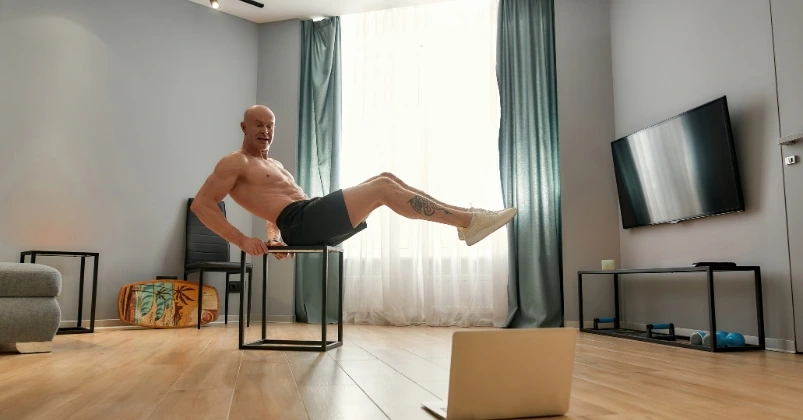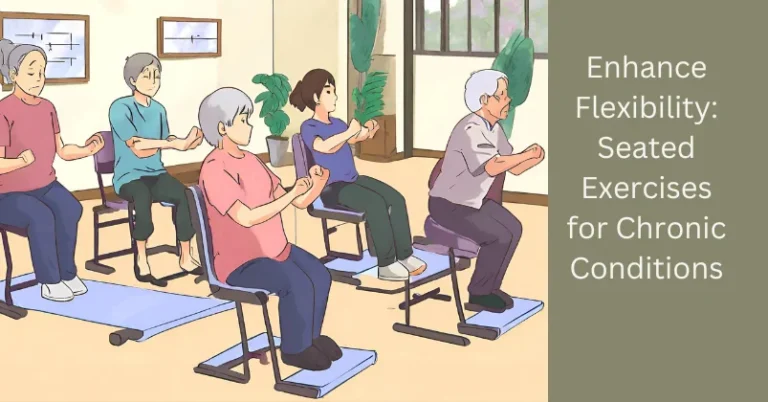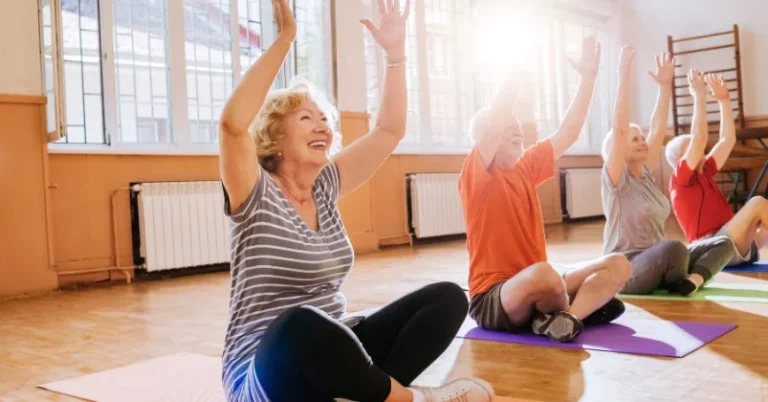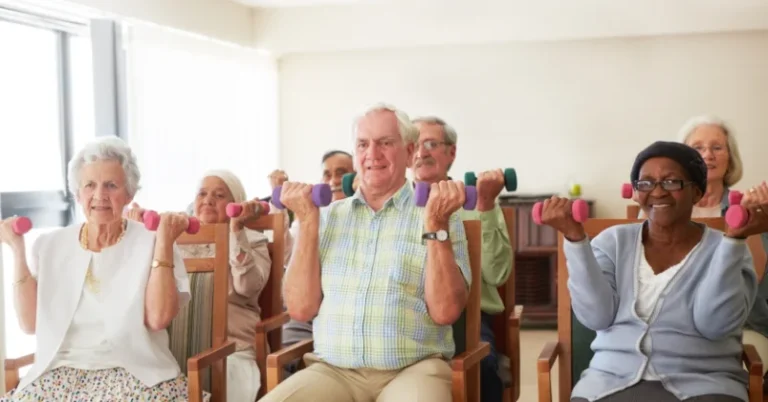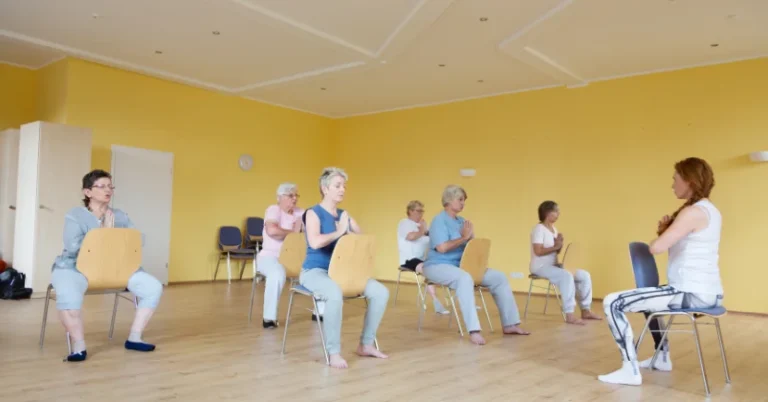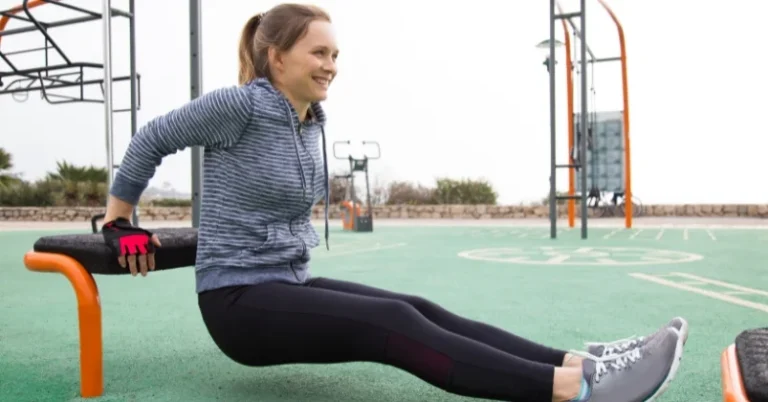Sit and Get Fit: Chair Exercises for Chronic Conditions – No Gym Required!
Chair exercises are a great way to improve strength, flexibility, and balance for individuals with chronic conditions. These exercises are performed while sitting in a chair or using a chair for support and are designed to be low-impact and gentle on the joints.
Chair exercises can be modified to suit individual needs and abilities, making them a safe and effective option for people with a wide range of chronic conditions.
For individuals with chronic conditions, staying active is crucial for maintaining physical function and overall health. However, many traditional forms of exercise may be too strenuous or high-impact for people with certain conditions.
Chair exercises provide a low-impact alternative that can help individuals stay active and improve their quality of life.
By incorporating chair exercises into their daily routine, individuals with chronic conditions can improve their strength, flexibility, and balance, which can help them perform daily activities more easily and reduce their risk of falls and injuries.
Whether you have arthritis, osteoporosis, or another chronic condition, chair exercises can be a great way to stay active and improve your physical function. With a wide range of exercises to choose from, you can tailor your workout to your individual needs and abilities.
By incorporating chair exercises into your daily routine, you can improve your strength, flexibility, and balance, and enjoy a better quality of life.
Understanding Chronic Conditions
Chronic conditions are long-lasting health conditions that require ongoing medical attention and management. They typically cannot be cured but can be managed with the right care, treatment, and lifestyle changes.
Some common chronic conditions include arthritis, diabetes, heart disease, stroke, type 2 diabetes, dementia, and Alzheimer’s disease.
People with chronic conditions often experience symptoms that can affect their quality of life, such as pain, fatigue, and difficulty with mobility. These symptoms can make it challenging to engage in physical activity, which is essential for maintaining good health and managing chronic conditions.
Fortunately, there are many chair exercises that can be done to improve physical fitness and overall health, even for those with chronic conditions. These exercises can be done while sitting in a chair, making them accessible and safe for people with mobility issues.
It is essential to consult with a healthcare provider before starting any exercise program, especially if you have a chronic condition. Your healthcare provider can advise you on the types of exercises that are safe and appropriate for your condition, as well as any modifications you may need to make.
Incorporating chair exercises into your daily routine can help improve your physical fitness, reduce pain and fatigue, and enhance your overall quality of life. With the right care and management, living with a chronic condition can be manageable and fulfilling.
Importance of Physical Activity
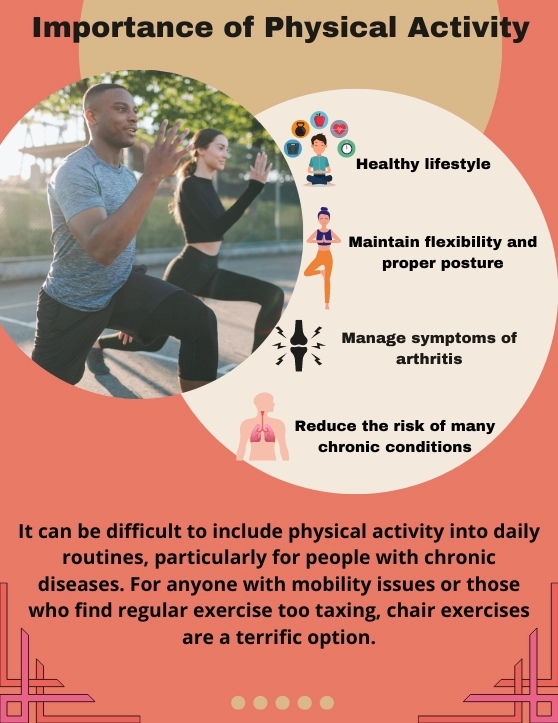
Physical activity is a crucial component of a healthy lifestyle, especially for individuals with chronic conditions. Regular exercise can help improve overall physical health, increase mobility and strength, and enhance control and balance.
It can also aid in maintaining flexibility and proper posture, which can help prevent further injuries.
Physical activity has been shown to reduce the risk of many chronic conditions, including type 2 diabetes, heart disease, and certain types of cancer. It can also help manage symptoms of chronic conditions such as arthritis, chronic obstructive pulmonary disease (COPD), and multiple sclerosis (MS).
Incorporating physical activity into daily routines can be challenging, especially for individuals with chronic conditions. Chair exercises are a great alternative for individuals with mobility problems or those who find traditional exercise too strenuous.
Chair exercises can help improve strength, flexibility, and balance, and can be tailored to individual needs and abilities.
It is important to note that physical activity should be done in moderation and under the guidance of a healthcare professional, especially for individuals with chronic conditions.
Starting with light intensity activities and gradually increasing the intensity and duration can help prevent injury and ensure the benefits of physical activity are maximized.
In summary, physical activity is an essential component of a healthy lifestyle and can help improve overall physical health, increase mobility and strength, and enhance control and balance.
Incorporating chair exercises into daily routines can be a great alternative for individuals with chronic conditions, but it is important to do so in moderation and under the guidance of a healthcare professional.
Benefits of Chair Exercises
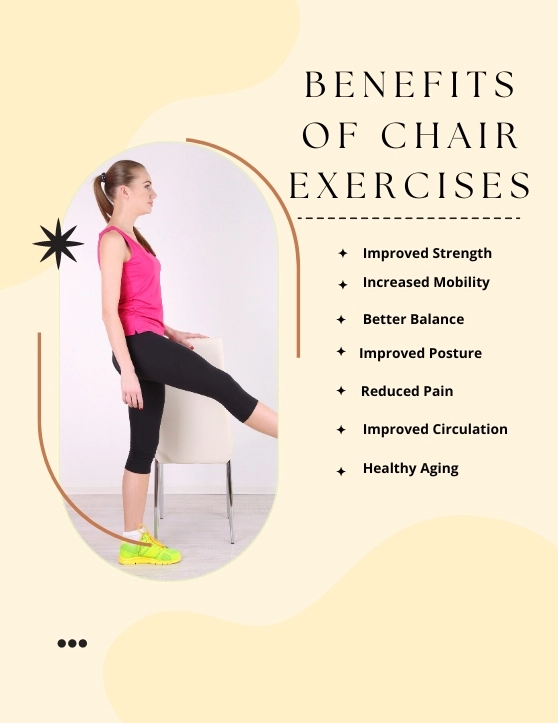
Chair exercises offer numerous benefits for individuals with chronic conditions. Here are some of the key benefits:
Improved Strength
Chair exercises can help improve muscle strength, which is important for maintaining independence and preventing falls. By regularly engaging in chair exercises, individuals can strengthen their muscles and improve their overall mobility.
Increased Mobility
Mobility is essential for maintaining independence, and chair exercises can help improve mobility in individuals with chronic conditions. Chair exercises can help increase range of motion and improve flexibility, making it easier to perform daily activities.
Better Balance
Chair exercises can also help improve balance, which is important for preventing falls. By engaging in exercises that focus on balance, individuals can improve their overall stability and reduce their risk of falling.
Improved Posture
Poor posture can lead to pain and discomfort, but chair exercises can help improve posture. By engaging in exercises that focus on posture, individuals can strengthen their core muscles and improve their overall alignment.
Reduced Pain
Chronic pain can be debilitating, but chair exercises can help reduce pain and discomfort. By engaging in exercises that focus on stretching and strengthening, individuals can alleviate pain and improve their overall quality of life.
Improved Circulation
Chair exercises can also help improve circulation, which is important for overall health. By engaging in exercises that focus on movement and flexibility, individuals can improve blood flow and reduce their risk of developing circulatory problems.
Healthy Aging
Finally, chair exercises can help promote healthy aging. By engaging in regular exercise, individuals can maintain their independence and improve their overall quality of life as they age.
Precautions Before Starting Exercise Program
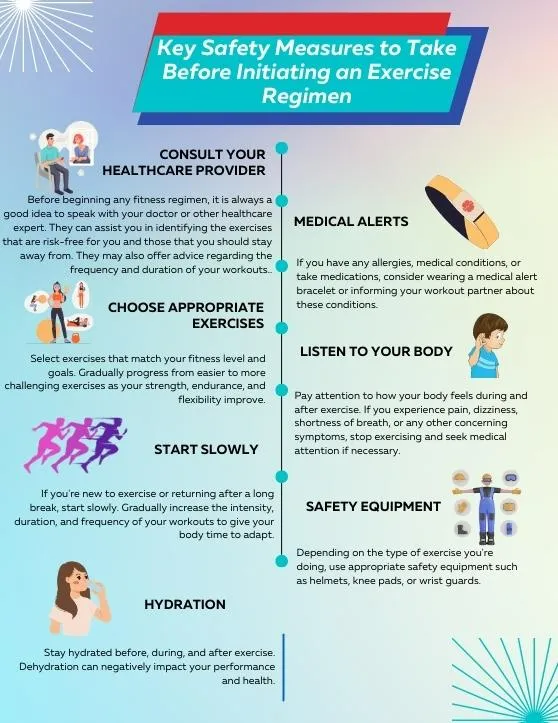
Before starting any exercise program, it is important to take some precautions to ensure your safety. This is especially true if you have a chronic condition or any health concerns. Here are some things to keep in mind:
Consult with Your Doctor or Healthcare Provider
It is always a good idea to consult with your doctor or healthcare provider before starting any exercise program. They can help you determine what types of exercises are safe for you, and which ones you should avoid. They can also provide guidance on how often and how long you should exercise.
Listen to Your Body
It is important to listen to your body when exercising. If you experience any discomfort, pain, or injury, stop the exercise immediately. If the discomfort persists, consult with your doctor or healthcare professional.
Take Precautions After Surgery
If you have had surgery, it is important to take extra precautions when exercising. Follow your doctor's instructions carefully and avoid any exercises that could cause injury to the affected area. If you experience any pain or discomfort, stop the exercise and consult with your doctor.
Watch for Dizziness or Fear of Falling
If you experience dizziness or a fear of falling, it is important to take extra precautions when exercising. Avoid any exercises that require you to stand up or move quickly. Instead, focus on seated exercises that are safe and effective.
By taking these precautions, you can help ensure your safety while exercising. Remember to always listen to your body and consult with your doctor or healthcare provider if you have any concerns.
Understanding Chair Exercises
Chair exercises are a great way to improve fitness and mobility for individuals with chronic conditions. They are low-impact and can be done from the comfort of a sturdy chair, making them accessible for people with limited mobility or balance issues.
With chair exercises, form and control are key. It is important to maintain proper posture and alignment throughout each movement to avoid injury and maximize the benefits of the exercise. Additionally, movements should be slow and controlled to prevent jerky or sudden movements that could cause pain or discomfort.
The level of fitness and mobility of the individual should also be taken into consideration when selecting chair exercises. Some exercises may require more strength or flexibility than others, so it is important to choose exercises that are appropriate for the individual's fitness level.
Weights can be incorporated into chair exercises to add resistance and increase the intensity of the workout. However, it is important to start with lighter weights and gradually increase the weight as strength improves.
Balance and mobility can also be improved with chair exercises. Exercises that focus on strengthening the core, legs, and hips can help improve balance and stability. Additionally, movements that require reaching or twisting can help improve flexibility and mobility.
For individuals with chronic pain, chair exercises can be a great way to stay active and improve circulation without putting additional strain on the body. It is important to listen to the body and avoid any movements that cause pain or discomfort.
Overall, chair exercises are a safe and effective way to improve fitness and mobility for individuals with chronic conditions. With proper form, control, and gradual progression, individuals can experience significant improvements in strength, balance, and mobility.
Chair Exercises for Upper Body
If you have a chronic condition that affects your mobility, you may find it challenging to engage in physical activity. But, chair exercises can help you stay active and improve your upper body strength. Here are some exercises you can try:
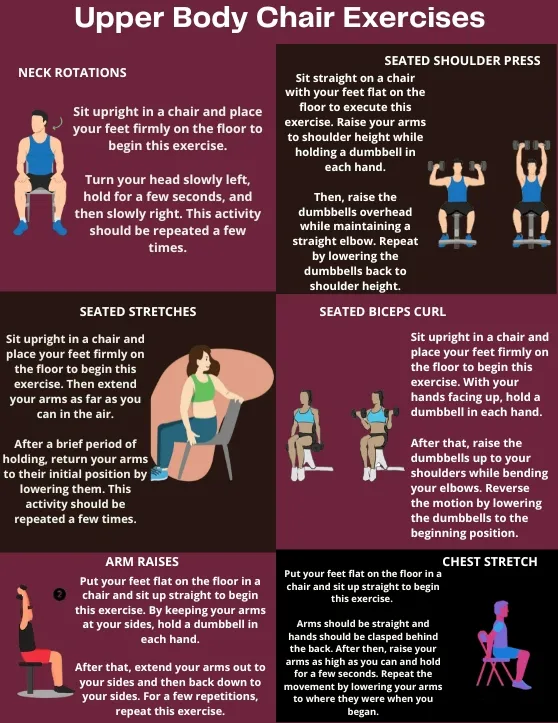
Seated Shoulder Press
The seated shoulder press is an excellent exercise that targets your shoulders and arms. To perform this exercise, sit straight in a chair with your feet flat on the ground. Hold a dumbbell in each hand and raise your arms to shoulder height.
Then, lift the dumbbells overhead, keeping your elbows straight. Lower the dumbbells back to shoulder height and repeat.
Seated Biceps Curl
The seated biceps curl is an effective exercise that targets your biceps. To perform this exercise, sit straight in a chair with your feet flat on the ground. Hold a dumbbell in each hand with your palms facing upwards.
Then, bend your elbows and lift the dumbbells towards your shoulders. Lower the dumbbells back to the starting position and repeat.
Chest Stretch
The chest stretch is a great exercise that targets your chest and shoulders. To perform this exercise, sit straight in a chair with your feet flat on the ground.
Clasp your hands behind your back and straighten your arms. Then, lift your arms as high as you can and hold for a few seconds. Lower your arms back to the starting position and repeat.
Arm Raises
Arm raises are an easy exercise that targets your shoulders and arms. To perform this exercise, sit straight in a chair with your feet flat on the ground. Hold a dumbbell in each hand and keep your arms by your sides.
Then, raise your arms to shoulder height and lower them back down. Repeat this exercise for a few repetitions.
Neck Rotations
Neck rotations are a simple exercise that targets your neck. To perform this exercise, sit straight in a chair with your feet flat on the ground.
Slowly turn your head to the left, hold for a few seconds, and then turn your head to the right. Repeat this exercise for a few repetitions.
Seated Stretches
Seated stretches are an easy exercise that targets your upper body. To perform this exercise, sit straight in a chair with your feet flat on the ground. Then, reach your arms overhead and stretch as far as you can.
Hold for a few seconds and then lower your arms back to the starting position. Repeat this exercise for a few repetitions.
Incorporating these chair exercises into your routine can help improve your upper body strength and overall physical health.
Chair Exercises for Lower Body
Maintaining lower body strength is essential for mobility and balance, especially for those with chronic conditions. Here are some effective chair exercises for the lower body:
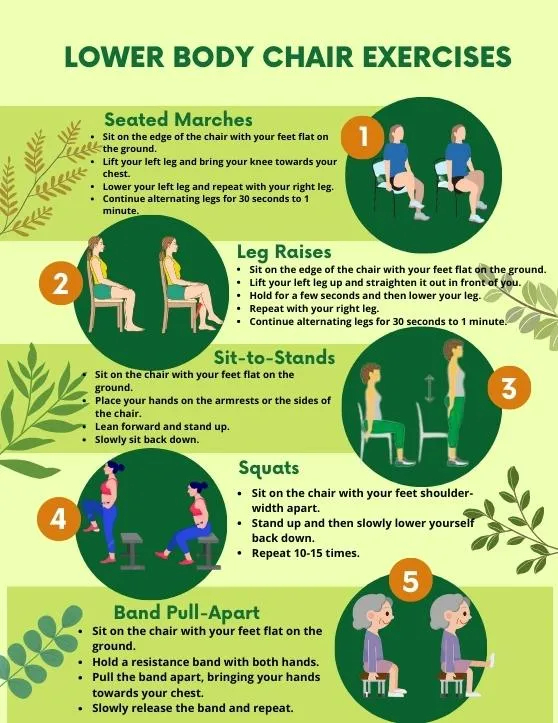
Seated Marches
- Sit on the edge of the chair with your feet flat on the ground.
- Lift your left leg and bring your knee towards your chest.
- Lower your left leg and repeat with your right leg.
- Continue alternating legs for 30 seconds to 1 minute.
- This exercise helps to strengthen the hip flexors and improve coordination.
Leg Raises
- Sit on the edge of the chair with your feet flat on the ground.
- Lift your left leg up and straighten it out in front of you.
- Hold for a few seconds and then lower your leg.
- Repeat with your right leg.
- Continue alternating legs for 30 seconds to 1 minute.
- This exercise helps to strengthen the quadriceps and improve knee extension.
Sit-to-Stands
- Sit on the chair with your feet flat on the ground.
- Place your hands on the armrests or the sides of the chair.
- Lean forward and stand up.
- Slowly sit back down.
- Repeat 10-15 times.
- This exercise helps to strengthen the glutes, hamstrings, and core muscles.
Squats
- Sit on the chair with your feet shoulder-width apart.
- Stand up and then slowly lower yourself back down.
- Repeat 10-15 times.
- This exercise helps to strengthen the lower body and improve balance.
Band Pull-Apart
- Sit on the chair with your feet flat on the ground.
- Hold a resistance band with both hands.
- Pull the band apart, bringing your hands towards your chest.
- Slowly release the band and repeat.
- This exercise helps to strengthen the upper back and improve posture.
Incorporating these chair exercises into your daily routine can help improve lower body strength and mobility. Remember to consult with your healthcare provider before starting any exercise program.
Chair Exercises for Core
Maintaining core strength is essential for overall health, especially for individuals with chronic conditions. Fortunately, there are several chair exercises that can help improve core strength and stability.
Seated Twist
The seated twist is a great exercise to target the oblique muscles, which are essential for core stability. Sit with your feet flat on the ground and your back straight. Hold the back of the chair with your right hand and twist your torso to the right, keeping your left hand on your right knee. Hold for a few seconds and then repeat on the other side.
Seated Circles
Seated circles are a simple yet effective exercise to engage the core muscles. Sit with your feet flat on the ground and your back straight. Place your hands on your hips and slowly circle your torso to the right, then to the left.
Seated Jumping Jacks
Seated jumping jacks are a low-impact exercise that can help improve core strength. Sit with your feet flat on the ground and your back straight. Place your hands on your thighs and jump your feet out and in, like a regular jumping jack.
Standing Exercises
For individuals who are able to stand, there are several exercises that can help improve core strength. Standing side bends, standing twists, and standing leg lifts are all effective exercises to target the core muscles.
Incorporating these chair exercises into your daily routine can help improve core strength and stability, leading to better overall health. As always, it is important to consult with your doctor before starting any new exercise program.
Incorporating Equipment in Chair Exercises
Incorporating equipment into chair exercises can add variety and challenge to your workout routine. It can also help you target specific muscle groups and increase resistance to build strength.
One common piece of equipment used in chair exercises is dumbbells. Dumbbells come in different weights and can be used to perform a variety of exercises, such as bicep curls, shoulder presses, and tricep extensions. Adding dumbbells to your chair workout can help increase the intensity and challenge of your exercises.
Another piece of equipment that can be used in chair exercises is resistance bands. Resistance bands are lightweight and portable, making them easy to use at home or on-the-go. They can be used to perform exercises such as chest presses, rows, and leg extensions. Resistance bands can also be used to modify exercises and make them easier or more challenging.
If you have access to a gym or personal trainer, there are additional pieces of equipment that can be incorporated into chair exercises. Cable machines, weight machines, and stability balls can all be used to perform exercises while seated in a chair. These pieces of equipment can help you target specific muscle groups and provide a greater challenge to your workout.
It's important to remember that when incorporating equipment into chair exercises, proper form and technique are essential. It's recommended to work with a personal trainer or physical therapist to ensure you are using the equipment correctly and safely.
Overall, incorporating equipment into chair exercises can add variety and challenge to your workout routine. Dumbbells, resistance bands, and additional gym equipment can all be used to target specific muscle groups and increase resistance to build strength.
Role of Professionals in Chair Exercise Program
Professionals play a crucial role in designing and implementing chair exercise programs for individuals with chronic conditions. These professionals may include doctors, physical therapists, personal trainers, healthcare professionals, and healthcare providers.
Doctors
Doctors play an essential role in providing medical clearance and identifying any potential health risks associated with exercise. They can also provide guidance on the type and intensity of exercise that is safe for individuals with chronic conditions.
Physical Therapists
Physical therapists can assess an individual's functional capacity and design an exercise program that is tailored to their specific needs. They can also provide guidance on proper body mechanics and ensure that exercises are performed safely.
Personal Trainers
Personal trainers can provide guidance on proper exercise technique and progression. They can also provide motivation and support to help individuals adhere to their exercise program.
Healthcare Professionals
Healthcare professionals, including nurses and physician assistants, can provide support and guidance to individuals with chronic conditions. They can also monitor an individual's progress and provide feedback on their exercise program.
Healthcare Providers
Healthcare providers, including hospitals and clinics, can provide resources and support for individuals with chronic conditions. They can also provide access to specialized exercise programs and equipment.
In conclusion, professionals play a critical role in designing and implementing chair exercise programs for individuals with chronic conditions. By working together, these professionals can help individuals improve their physical function, reduce their risk of falls, and enhance their overall quality of life.
Impact of Chair Exercises on Daily Activities
Chair exercises are an effective way to improve physical function and mobility in individuals with chronic conditions. These exercises can help to improve balance, strength, and flexibility, which can have a significant impact on daily activities and overall quality of life.
For individuals with mobility issues, chair exercises can be a safe and effective way to improve physical function. These exercises can help to improve muscle strength and flexibility, which can make it easier to perform daily activities such as getting up from a chair, walking, and climbing stairs.
Chair exercises can also be beneficial for individuals with balance problems. These exercises can help to improve balance and stability, which can reduce the risk of falls and improve overall mobility.
In addition to improving physical function, chair exercises can also help to promote independence. By improving strength and mobility, individuals may be able to perform daily activities more easily and with less assistance.
Overall, chair exercises are a valuable tool for individuals with chronic conditions who are looking to improve their physical function and quality of life. By incorporating these exercises into a daily routine, individuals can experience significant improvements in mobility, balance, and independence.
Sit, Stretch, and Conquer: The Unlikely Hero in Fighting Chronic Conditions – Chair Exercises!
Chair exercises are a safe and effective way for individuals with chronic conditions to improve their physical activity levels and maintain healthy aging. According to the Centers for Disease Control and Prevention (CDC), regular physical activity can help manage chronic conditions such as arthritis, diabetes, and heart disease. Chair exercises can be a convenient option for those who may have difficulty standing or walking for extended periods.
Implementing an exercise program that includes chair exercises can help improve strength, flexibility, balance, and overall physical function. Studies have shown that multicomponent exercises involving chair yoga and tai chi can be particularly beneficial for older adults with chronic conditions. Additionally, incorporating light intensity activity and strength and balance activities can help preserve physical function.
When starting a chair exercise program, it is important to consult with a healthcare provider to ensure that it is safe and appropriate for an individual's specific needs and condition. It is also important to start slowly and gradually increase intensity and duration over time.
Overall, incorporating chair exercises into a daily routine can have numerous benefits for individuals with chronic conditions. By improving physical function and promoting healthy aging, individuals can improve their overall quality of life and manage their chronic conditions more effectively.
FAQs
A: If you're looking for gentle exercises that can be done while sitting in a chair, you might consider arm circles, seated marches, and seated leg lifts. These exercises can help to improve circulation, flexibility, and range of motion.
A: Chair exercises can be a great way to help manage chronic conditions such as arthritis, diabetes, and heart disease. Some examples of chair exercises that may be helpful include seated rows, seated squats, and chair yoga.
A: If you're looking for leg exercises that can be done while sitting in a chair, you might try leg extensions, seated leg curls, and calf raises. These exercises can help to strengthen the muscles in your legs and improve your balance.
A: There are many free resources available online for chair exercises for seniors. Some great places to start include the National Institute on Aging, SilverSneakers, and AARP.
A: If you don't have any equipment on hand, there are still plenty of seated exercises that you can do. Some examples include seated twists, seated marches, and seated leg lifts.
A: The recommended exercises for individuals with chronic illnesses will depend on the specific condition and the individual's health status.
In general, it's a good idea to talk to your doctor or a physical therapist before starting any new exercise program. They can help you to determine which exercises are safe and effective for your specific needs.

